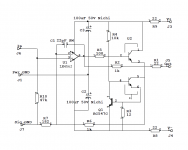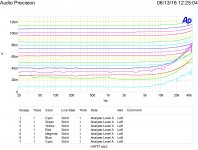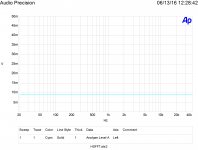I have tried it on JPEG, TIFF, PNG, WAV, FLAC and MP3 files. I found that it took rather large blocks of altered data to notice anything. One bit? Can't see it, can't hear it. No way.
Curious, FLAC has built in CRC error checking. I believe some of the other formats also have built in error checking. https://hydrogenaud.io/index.php/topic,38795.0.html and http://www.blisshq.com/music-library-management-blog/2015/03/31/test-flacs-corruption/
And if you want to see if the lossless file was really lossless Lossless Audio Checker
Now that I reflect, just to make clear: I wasn't alleging that the bootstrapped or neutralized input capacitance would reduce the noise, just reduce the distortion at the input with a highish Z source, given that any residual capacitance will be voltage-dependent, indeed as well nonlinearly voltage-dependent, and thus be a distortion mechanism.Yes I agree---one gets down to MM/MI cartridge thermal pretty quickly with a single modern JFET. ...
But induced gate noise may well set a limit to the benefits of device paralleling.
Do you? Then the comment below is invalid due to the 5534 input current noise 3-4.5pA/rtHz @ 30Hz, rendering about 4nV/rtHz for a modest 1kohm impedance @1KHz MM, therefore doubling the 5534 input voltage noise, to a total of about 6-7nV/rtHz. You would be much better even with a good jfet input opamp.
You are taking things out of context again to suite your agenda.
I said you would not beat the cost-performance of a 5534 not that it was the lowest noise solution.
Shop around and the lowest noise version is about 50c IIRC, 1% SMD COG's in volume are pennies as are 1% thin film 1206 resistors. You get great PSRR, overload margin etc.
If you want +10 dB better noise performance then use JFETs (in parallel) and accept increased cost and complexity.
Last edited:
I happened very recently on a preamp article that used a 2SK117 prefacing a 5534 in a 1985 Audio Amateur.
That would be the preeminent preamp from JR?
BTW 3 bucks for an NE5534 in 1985 dollars? We've come a long way down from that!
Jan
Last edited:
Bonsai, why would DIYers care whether the ICs in their self built phono stages cost $1 or $30? Compared to the other expenses in home building a finished piece (including chassis, power supply, PCB fab) it's a very small uptick. And when you consider cost per hour of listening enjoyment, before discarding this gear and building its replacement, the extra few dozen dollars of initial outlay are insignificant.
I'm just sayin' that the best bang for the buck MM phono is with a 5534 Mark. If a builder feels another device is better and costs $30, so be it.
For ultra low noise, I would go with parallel BF862's in a single ended configuration. 🙂
Mark, that seems a logical fallacy: why should a diyers, regardless the other expenses, pay any more for any specific part than absolutely what is needed to achieve their objective? I certainly wouldn't spend a couple hundred extra on a TV/appliance to get exactly the same result..
I'm imagining people who wish to use opamps like OPA1611 (datasheet) that cost $5 each but spec 1.1 nV/sqrtHz, better than the 5534. Or people who want to try their hand at taming the famously tempermental (but famously low noise) AD797 at $10.50 each. Remember to double the prices if you like to compare against the 5532 dual opamp.
I'm also imagining people who cascade a high current, possibly class A, high bandwidth output stage after their low noise IC gain stage, example below. This costs more than the $1.00 NE5534 but DIYers may want to try it anyway.
_
Attachments
Last edited:
You are taking things out of context again to suite your agenda.
True, my secret agenda was set over the weekend by the World Government at the Bildenberg group meeting in Dresden.
Of course some go out of their way to increase cost. LCR phono stages being a good one .Why use a 10c capacitor when you can chuck a $50 inductor at it. The Tango EQ transformers of yore seem to sell for thousands now. Common sense rarely prevails when vinyl is involved. But its only a hobby 🙂
True, my secret agenda was set over the weekend
Surely you meant Rothschild
(Mr Johnson appears as not of the Dot com generation)
I have tried it on JPEG, TIFF, PNG, WAV, FLAC and MP3 files. I found that it took rather large blocks of altered data to notice anything. One bit? Can't see it, can't hear it. No way.
Maybe my bad luck, one bit that defines a decode table would trash a lot in some compressed formats. You list a couple of uncompressed formats which would only trash one sample or pixel.
As to the original intent of the thread do you have any reason to suspect normal opening, closing, copying of files has an error problem at any noticeable level? Or how about cache which is exercised continuously during compute intensive operations?
[but I can only measure to 6GHz]
THx-RNMarsh
But then you won't see them oscillating at 18GHz. 😉 IME these devices are pretty bad for noise at low frequencies some have 1/f corners of 10MHz.
EDIT - the noise has improved a lot but the betas still seem to be low.
Last edited:
It is the JR preamp, yes, which was sold as a kit.That would be the preeminent preamp from JR?
Maybe my bad luck, one bit that defines a decode table would trash a lot in some compressed formats. You list a couple of uncompressed formats which would only trash one sample or pixel.
As to the original intent of the thread do you have any reason to suspect normal opening, closing, copying of files has an error problem at any noticeable level? Or how about cache which is exercised continuously during compute intensive operations?
Mr. Wurcer, at least in the mpeg compression that I am more familiar with, the individual bits can have any value within the spatial or temporal compression frames. Altering one or more bit could worst case compromise an entire frame, which may or may not be subjectively noticeable, but certainly would not crash the decompressor. There is nothing like a checksum in the mpeg standard.
Removing a random number of bits from the compressed file could screw the entire remaining file and may cause the decompressor to abort. The later is unlikely to happen due to corrupted mpeg frame structure, but because the possible corruption of meta data in the file (typical would be the optional mpeg time stamps).
When I was working on spectrometer electronics in the late 70s I was very ambitious to use the fastest parts I could find, and I managed to do so. I wish I'd taken a few photos of some of the circuit boards, particularly the places where I was close-packing TO-72 case devices, as they would look very quaint today compared to SMD. But things worked. However in time I realized that the added lossy components needed to tame parasitics reduced the bandwidth to the point I might well have been better off using slower parts to begin with.But then you won't see them oscillating at 18GHz. 😉 IME these devices are pretty bad for noise at low frequencies some have 1/f corners of 10MHz.
One of the revelations was just how low the collector impedances could be for fast devices. I have a friend who defaults to treating bipolars as having zero conductance at the collector, which in some situations might be a good initial approximation but of course fails miserably in others.
I'm imagining people who wish to use opamps like OPA1611 (datasheet) that cost $5 each but spec 1.1 nV/sqrtHz, better than the 5534. Or people who want to try their hand at taming the famously tempermental (but famously low noise) AD797 at $10.50 each. Remember to double the prices if you like to compare against the 5532 dual opamp.
I'm also imagining people who cascade a high current, possibly class A, high bandwidth output stage after their low noise IC gain stage, example below. This costs more than the $1.00 NE5534 but DIYers may want to try it anyway.
_
No problem, Mark, my point was more to contrast the massive scope creep known as diy anything. You know the kind where a small weekend project to fix the grout around the sink ends up resulting in a new kitchen 6 months and 4 contractors later. 😀
HUMOR!
Attached is a plot of a string of twenty 2 ohm resistors fed via a 1,000 ohm unit. The frequency response is measured at each tap. The parts were on a solderless breadboard.
The second plot is a single 2 ohm resistor just clipped to the 1,000 ohm unit.
Attached is a plot of a string of twenty 2 ohm resistors fed via a 1,000 ohm unit. The frequency response is measured at each tap. The parts were on a solderless breadboard.
The second plot is a single 2 ohm resistor just clipped to the 1,000 ohm unit.
Attachments
I'm imagining people who wish to use opamps like OPA1611 (datasheet) that cost $5 each but spec 1.1 nV/sqrtHz, better than the 5534. Or people who want to try their hand at taming the famously tempermental (but famously low noise) AD797 at $10.50 each. Remember to double the prices if you like to compare against the 5532 dual opamp.
I'm also imagining people who cascade a high current, possibly class A, high bandwidth output stage after their low noise IC gain stage, example below. This costs more than the $1.00 NE5534 but DIYers may want to try it anyway.
_
Ha ha - good attachment! Still only costs pennies to get class A
🙂
Unfortunately, adding a discrete output stage is usually cumbersome, compared to the use of the IC by itself. Fast IC buffers are more compact, but are really expensive for what they do. Major designers often load down an IC with a load that is below its rating, for practical (for them) reasons like setting the gain or keeping the noise as low as possible. Here is where a good IC buffer could be useful, but they are still expensive and cannot easily be universally applied with cost sensitive (but hi quality) products like OPPO, in every case. This is a problem.
Maybe not bad luck, maybe just well chosen bits in my case. 🙂 I generally go 1/3, 1/2 or 2/3 of the way down the file, find some value and change it. It never passes a a checksum after that, but it doesn't crash or make a noticeable difference.Maybe my bad luck, one bit that defines a decode table would trash a lot in some compressed formats. You list a couple of uncompressed formats which would only trash one sample or pixel.
The reason I've done this was simply to check that I was getting bit perfect copies by whatever method I used to transmit them. I wanted to change just one bit by hand to see if the checksum really worked. It does. And I've had no problem getting bit perfect copies. That is the main point.
I'm game to do some more bit hacking to see if I can crash a compressed file, like FLAC. I will report my findings here.
By the time I finish a unity-gain buffer, usually I've spent six transistors, two complementary e-follower or source-follower output devices, two complementary input devices, and two current sources, usually LED-biased. It's usually something fast enough to not spoil the gain-bandwidth of the preceding stages. But it is cumbersome, and not so much expensive in terms of parts but demanding of PCB area.
The stage can be biased as richly as one desires.
Anyone remember the Burr-Brown modified TO-3 package buffer, the 3553? I see someone wants 200 US for one.
The stage can be biased as richly as one desires.
Anyone remember the Burr-Brown modified TO-3 package buffer, the 3553? I see someone wants 200 US for one.
- Status
- Not open for further replies.
- Home
- Member Areas
- The Lounge
- John Curl's Blowtorch preamplifier part II


